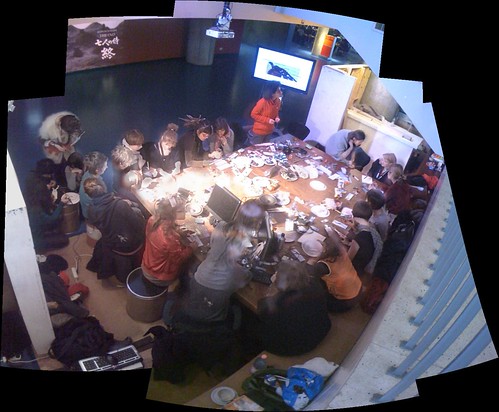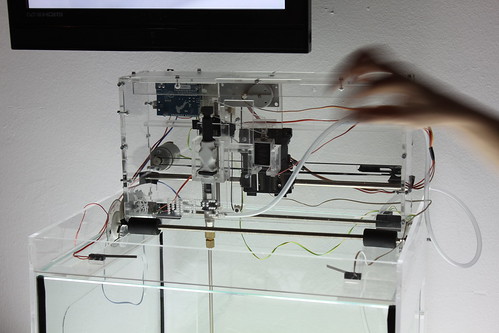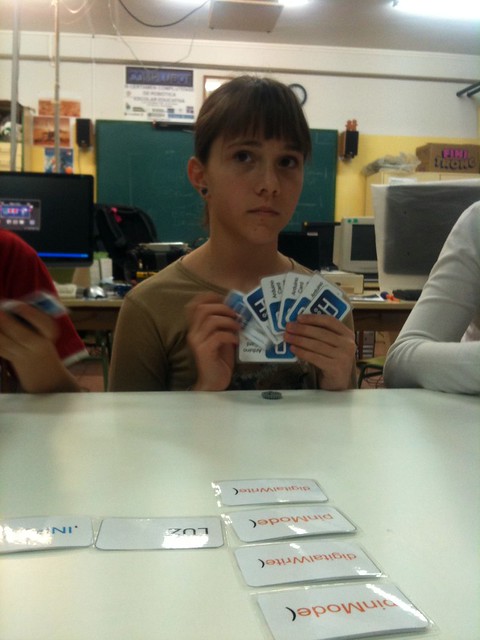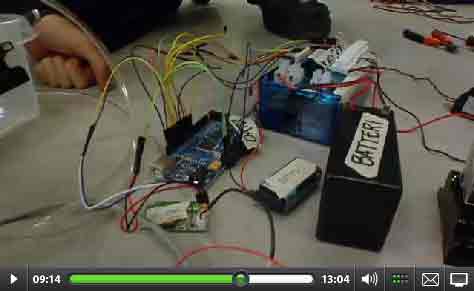LEARN PROGRAMMING PLAYING CARDS
– February 14th, 2011
Let’s say you are 9 and you want to learn how to program … syntax is hard, and it is usually one of the issues I find when teaching. But also, language is problematic, not everybody speaks/reads/writes English and most programming languages are written in English … Arduino’s is not an exception. The guys at Complubot are into something interesting when it comes to learn programming. They are now in the third iteration of a cardgame (name to be decided) using the Arduino syntax.
The idea behind the game is simple. The players get some cards representing parts of a program and their goal is collecting points. You get one point for every card you put on the desk and twice as many if you are closing a command. The player with the bigger amount of points when someone is closing the loop is the winner. Closing the setup or loop functions will give you 10 points at once.
Players are allowed to place cards on the desk as long as they are making sense with whatever has been placed already. E.g. you cannot build the line “digitalWrite( LUZ, valor );” if “LUZ” or “valor” haven’t been declared earlier on in the program.
I played one match this Saturday night and I realized how easy it becomes to discuss about programming when sitting around the table dealing with small Lego pieces as a currency. I could explain the idea of precompilation in a such an easy way that I am still amazed by it. Complubot is making a terrific job in teaching kids how the world of electronics works. Remember they are in a campaign to gather the funding they need to build their next generation competition robots. Just follow this link and send them some of your appreciation.
PS. as for the game, they will release it together with the design files once the rules are a more set, there are still some flaws that have to be polished 
PS2. more pictures can be found here.
PS3. yeah, I lost the game … I am pretty bad playing whatever game
YET ANOTHER SUPER HERO USING ARDUINO
– February 14th, 2011
WHY THE ARDUINO WON AND WHY IT’S HERE TO STAY
– February 11th, 2011

Philip Torrone on Makezine debates in a very interesting editorial about the Arduino success, and the ongoing development of new boards similar to our favorite.
In about a week, a rep from a large chip company is going to stop by and show me another “Arduino-like platform,” aka The Arduino Killer. This a pretty regular occurrence around here; every month or so there’s a company or person who wants to make the “next Arduino.” They usually contact me because I’ve covered the Arduino for years, helped get it in the maker world, and I use it daily in my work at Adafruit. I think it’s had an amazing impact on electronic hobbyists and artists, perhaps as much as the personal computer in the early days (Homebrew Computer Club, etc). There are more than 100,000+ Arduinos on the market, and by my estimates, a lot more when you add in the derivatives (approximately 150K as of 2/2011). Within the next 5 to 10 years, the Arduino will be used in every school to teach electronics and physical computing — that’s my prediction. There’s no going back.
Which are the reasons of this success? A must-read sum-up of the different levels that make Arduino well… Arduino.
Keep reading it on [MAKE]
OPEN SOURCE HARDWARE DEFINITION V.1.0 RELEASED
– February 10th, 2011
Last year, Massimo, David Mellis, and I attended the Open Hardware Summit in New York, and began working with several others at the summit on a definition and statement of principles for producing open hardware. We’re happy to announce that after several months of discussion, writing, and debate, version 1.0 of the open source hardware definition and statement of principles has been released. Shepherded gently but fiercely by Ayah Bdeir, the definition is a good starting point to talk about what open source hardware is, what best practices are, and how the businesses making it work. My hope is that it will lead to more mainstream adoption of open source hardware practices.
Ayah writes:
Now, to move forward, please HELP:1. Endorse the definition, post your feedback on version 1.0 on the forum and the mailing list as we work towards a 1.1 update in the next few weeks / months.2. Take a look at the logos we are considering for “open source hardware”, give feedback or submit your own logo on the forum, in the thread LOGO.3. Show your support of the OSHW Definition by applying the definition to your work/project/websiteThis is a very important step in propelling our movement forward. PLEASE FORWARD FAR AND WIDE.
DIY FEMINISM AT TRASMEDIALE 11: INTERVIEW WITH MZBALTAZAR
– February 10th, 2011

I’ve spent part of last week walking around Trasmediale 11 in Berlin, attending to workshops and conferences or simply having a good time with some firends (it’s what we call “press activities”…).
One of the oddiest images I’ll keep from this exprerience it has been well pictured in the photo above (thanks to Julien Dorra for sending it): 15 women hacking electronics devices around a table, creating interactive objects for fun. That’s what the DIY Feminism Workshop held by MzBaltazar was about.
But there’s more.
CONTRIBUTIONS NEEDED
– February 8th, 2011
I have been blogging a couple of times about the Complubot robotics team. It is the robotics team made of kids, based in Madrid, that has won the class B Soccer world championship the last 3 years. The team has existed for over 8 years and has until now had a list of dedicated sponsors to help them build the robots for the next competition.
It is a rule that the robots have to be build by the kids. The whole process is open source, since they kids have to present publicly how they made the robot as a proof they didn’t get any external help with it. I have been making personal donations to the team in the form of boards during the last year. Now, that all their big sponsors fell off, it has become time for crowdsourcing their activities.
This is a call for you all with either the materials or the money needed by this kids to get their robots running to donate. Please visit their website, get to know their story (EN, ES), and contribute! At their website you will as well find how to make your own Arduino based robot using servos, how kids can build Paperduino boards, or explanations to the way they teach algorithms using theater. Remember, 25Eur are cool, but 100Eur are much cooler … and even more when you know they will help these kids education.
This list includes the equipment needed for us to finish our robots. It includes just what we need to make it to the competition.
- 10 – Set motor-gear-encoder
- 3 – Digital compass
- 12 – LIPO batteries
- 4 – LIPO battery chargers
- 3 – Power Supply 12V/10A
- 6 – Arduino Motor Shield
- 10 – 12V DC motores
- 15 – Ultrasound sensors
- 64 – IR receivers
- 6 – Atmega328p processors
- 3 – Arduino Mega
- 3 – Arduino Mega Sensor Shield
- 3 – Arduino Nano
- 3 – Arduino Nano Sensor Shield
- 3 – OLED Module
- 4 – Electromagnetic actuator
- 2 – Metallic molds for working with carbon fiber
- Bolts and screws in M3 and M2.5 of different lenghts
- Bolts and screws in nylon M3 of different lengths
- Cables, connectors and other electronic components
- PCB manufacturing materials
- Epoxy and other types adhesives
HEART SPARK LOGGING & BLINKING YOUR BEAT
– February 2nd, 2011

Sensebridge is a little board that logs up to 61831 heart beats, about 14 hours of data. It is based on a atmega 168, a Real Time Clock, and 512 Kbit EEPROM. And it’s released open source.
The Heart Spark is a heart-shaped pendant which flashes little lights (light emitting diodes, LEDs) in time with your heart beat. A polar chest strap with transmitter (sold separately) is used to measure your heart beat, which is transmitted wirelessly to the pendant. An arduino-compatible circuit captures each beat as it happens and flashes LEDs (later versions will log data to an onboard EEPROM – see below). The pendant is carefully designed to maximize its visual appeal, including symmetry and optionally a high-gloss epoxy coating (as pictured to the right). A CR2032 coin-cell battery provides 8+ hours of battery life. Two small switches on the back allow selection of operating mode:
via [SenseBridge]
CUSTOMIZE YOUR CAR’S ELECTRONICS USING ARDUINO
– February 1st, 2011
Customizing your car with Arduino is getting easier and easier, with plenty of examples online. After the MPGuino Community, different OBD and CAN shields, we welcome the JEEPuter:
The JEEPuter is a programmable push-button system for controlling things like ignition, GPS navigation system, CB radio, RF scanner, 110V inverter, external and internal lights, and garage lights too. The JEEPuter also has temperature and light sensors which can set the dash lights and internal lights on autopilot. As a final touch, the Jeep’s ignition starts when you type a passcode instead of turning a key. While the JEEPuter is specifically for the Jeep Wrangler, you can learn from the build and apply the techniques to your own car.
via [Hack'n'Mod] source [JEEPuter]
FLUID DRESSES AND OTHER CASUAL PROFANITIES
– January 31st, 2011
[Charlie Bucket] is developing a personal look towards materials: pumping fluids in tubes to change objects’ (and cloths’, as you see in the video) substance and feeling. Magic-like.
The installation is based on openFrameworks, and uses 6 arduino-driven pumps to make the fluid flowing through the tubes. Very interesting fabrication pictures on Flickr.
More on [Hex.la] Source [CasualProfanity]
(FAB)BOTS, CUSTOMIZED ROBOTICS DEVICES FOR DESIGN AND FABRICATION
– January 28th, 2011

We had the chance to visit (FAB)BOTS: Customized robotic devices for design and fabrication not long ago in DHUB Barcellona. We were honoured to visit the center (and it’s Fablab) with the exhaustive and passionate explanation of Marta Malé-Alemany, the curator of the exhibition.
(FAB)BOTS presents a collection of 10 student projects from the Architectural Association (AA) School of Architecture and the Institute for Advanced Architecture of Catalonia (IAAC), developed in two design studios tutored by Marta Malé-Alemany, in collaboration with Jeroen van Ameijde (in London) and Victor Viña (in Barcelona).














0 comentarios:
Publicar un comentario